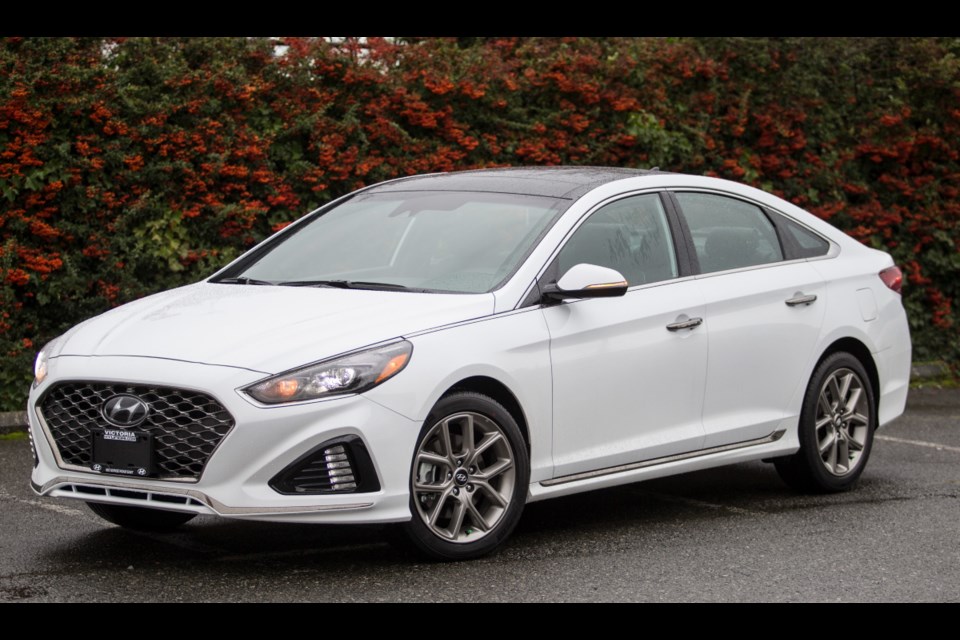The 2018 Hyundai Sonata is a testament to the fast-paced environment car manufacturers operate within ŌĆö and the lengths some will go to keep their offerings fresh and appealing to consumers.
Auto manufacturers update their vehicles periodically. Some, such as Hyundai, give models a major overhaul every four years ŌĆö you can set your watch by it.
In car terms, each overhaul is called a generation.
The 2018 Hyundai Sonata is in its seventh generation. But in the case of the Sonata, the generation started only two years ago, so it is in the middle of its current cycle, which means there is nothing fundamentally new to report.
ThatŌĆÖs not good enough in a fast-paced market, so Hyundai has gone for a mid-cyle refresh (or facelift) instead.
This refresh allows the designers to tweak the look of the car, so as to reflect a new corporate change in styling.
The main focus of a refresh usually means a change to the look of the grille and tail, with the former receiving the lionŌĆÖs share of the designerŌĆÖs time.
The 2018 Sonata does look more aggressive than last yearŌĆÖs car, with a larger, gaping grille ŌĆö currently fashionable among certain German offerings.
The cabin has also been updated, with the most noticeable change a flat-bottomed steering wheel (another item fashionable in up-market German vehicles) and a new centre stack with an eight-inch touchscreen infotainment system.
Rotary knobs seem to be making something of a comeback after being banished from some dashes, and the 2018 Sonata reflects that.
Hyundai has upped its game insofar as cabin materials are concerned. The interior surfaces have a mix of soft, hard, reflective and matte-black elements ŌĆö a tapestry that is cohesive and attractive.
Bear in mind that I had as a tester the Sonata 2.0T Sport model, the top of the line. In this model, occupants are welcomed with two-memory black leather sport seats with grey piping, 3-D metallic inlays, a wireless charging pad, panoramic sunroof, heated and ventilated front seats and rear side-window shades.
If you got a feeling that many of these items are typically found on more premium offerings, you are not mistaken. Your least expensive Sonata starts at $24,799. My tester carried a manufacturerŌĆÖs suggested retail price of $36,999.
There are few changes under the hood. Like last year, most Sonatas come equipped with a direct-injection 2.4-litre naturally aspirated four-cylinder and a six-speed automatic transmission.
The 2.0T gets (you guessed it) a 2.0-litre turbocharged engine producing 245 horsepower and 260 foot-pounds of torque. For 2018, the 2.0T gets two extra gears to its transmission, now boasting eight gears and paddle shifters on the steering wheel.
The extra power makes the Sonata an eager dance partner when it comes to letting your hair out on country roads. If I was put into the Sonata blind, I might have guessed I was behind the wheel of a car engineered in Europe, not Asia ŌĆö itŌĆÖs that good.
You can, like many cars these days, choose between a number of driving modes. These modes change steering effort, transmission shifts points and so forth. In Sport, the Sonata is enthusiastic with seemingly no vices. Bury your foot to the carpet and the car will happily reach redline before shifting.
The Sonata has one driving mode that is a first for me: Smart mode. Hyundai claims placing the car in Smart mode allows the car to choose between the other three modes ŌĆö Comfort, Eco and Sport. It claims the car will adjust to a driverŌĆÖs style and environmental factors to deliver power when needed, but also eke out the last drop of fuel when just cruising on the highway.
Keep in mind that this is a mid-sized four-door sedan we are taking about.
The 2.0T has one other ace up its sleeve ŌĆö larger low-profile wheels and rubber. While the base and mid-level cars get 16- and 17-inch rubber, the 2.0T ups the game with low-profile 235/45 R18 tires that fill out the wheel wells nicely. The wider and lower wheels no doubt contribute to better handling, with no loss to comfort.
The 2.0T also comes with a full slate of active safety features, including autonomous braking and pedestrian detection, cross-traffic alert, driver-attention alert, lane departure with lane-keep assist and rear parking sensors. It also has an adaptive cruise control with stop-and-go capability.
A mid-cyle refresh for some vehicles can be a dull affair. Hyundai has taken it very seriously and has attempted to improve upon an already good platform. Other manufacturers can learn from its example.
THE SPEC SHEET
Type: Mid-sized four-door sedan, front engine, front wheel drive
Engine: Turbocharged 2.0-litre four-cylinder, 245 hp at 6,000 r.p.m., 260 lb.-ft. of torque at 1,350 to 4,000 r.p.m.
Transmission: Eight-speed automatic
Dimensions (mm): Length, 4,855; width, 1,865; height, 1,475; wheelbase, 2,805
Curb weight (kg): 1,640
Price (base/as tested): $36,999/ $38,904 (includes $1,805 freight and PDI and $100 AC tax)
Options: Nil
Tires: 235/45 R18 on alloy wheels
Fuel type: Regular
Fuel economy (L/100km): 10.4 city/ 7.4 highway
Warranty: Five years/100,000 km new car and powertrain. Five year/unlimited km roadside assistance



